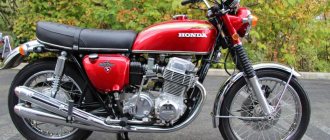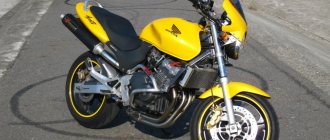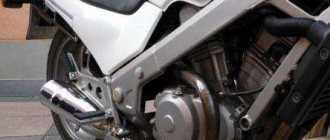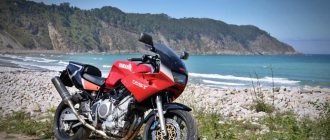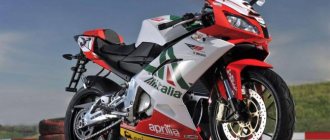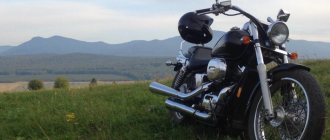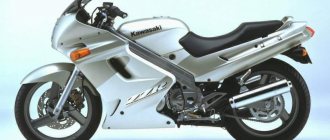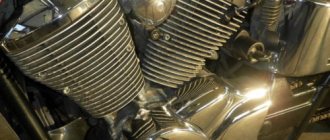The Honda CBF 1000 sports motorcycle is much more agile than the classic representatives of the touring class. Such an athlete is calm and balanced, always ready to use his impressive muscles. The CBF 1000 has the potential of a Honda Fireblade sports engine. This is an important, although not the only advantage that brought the motorcycle great popularity.
History of Honda CBF 1000
The CBF 1000 debuted in the 2006 season, two years after the premiere of the CBF 600 and a year after the launch of the CBF 500. Honda created an attractive and comfortable motorcycle for daily use with a slightly sporty touch.
In 2010, structural cosmetic changes were made. For the 2010 season, the CBF 1000 was joined by an F version with a more powerful engine, a larger front window and a completely new instrument panel equipped with an LCD display. The new 4-into-1 exhaust system gives the model a sportier look. Both versions were offered in parallel throughout the year. But in 2011, only the modernized version remained, and the previously added abbreviation F fell off from the name. The modern CBF 1000 engine has a multifunctional catalyst and complies with the Euro-3 standard.
Operating experience
When driving, not very wide tires contribute to maneuverability. You can't complain about the brakes either. Everything works flawlessly. Both driver and passenger have plenty of space. The Honda CBF 1000 provides a comfortable driving position for the driver during everyday driving around the city and on long routes. The Honda manufacturer has taken care of the possibility of purchasing factory accessories, such as luggage sets.
Competitors of the Honda CBF 1000
In testing since 2007. The CBF 1000 is shared with its first market competitors - the Suzuki Bandit 1250 S and the Suzuki Bandit 1200 s. According to the majority, the victory goes to Honda, even though it has a smaller engine capacity. Another competitor is a motorcycle from the same company, but with an automatic transmission, this is the Honda dn 01.
Modifications
The manufacturer produced two versions of the road motorcycle:
- The first generation, Honda CBF 1000, was produced from 2006 to 2009. The version was equipped with a 98-horsepower engine, a steel frame, a 19-liter fuel tank and an analogue instrument panel.
- The second generation, produced since 2010, is the Honda CBF 1000F. The motorcycle received an aluminum frame, a 106 horsepower engine, a 20-liter fuel tank, a digital instrument panel, more advanced suspension with front fork preload adjustment and HMAS rear shock absorber rebound adjustment, and a 4-in-2 exhaust system. The model is still produced and offered by official dealers in European markets.
The classic modification of the Honda CBF 1000 with round optics and without a plastic body kit was created on the basis of the steel frame of its younger classmate - the CBF 600.
The second generation went on sale in 2010 after serious modifications. The steel frame was replaced by a light alloy one, a plastic fairing appeared, engine settings changed, the volume of the fuel tank increased and fuel consumption decreased. The second generation Honda CBF 100, unlike the first generation models, received a digital rather than analog instrument panel and became significantly lighter due to the reduction in frame weight.
The second generation CBF 1000F, equipped with a plastic body kit, is most often classified as sports touring motorcycles. Despite the fact that such a classification is very doubtful, many motorcyclists and experts in reviews of the Honda CBF 1000 still admit that the Japanese bike is ideal for the title of road motorcycle. It has good autonomy thanks to low fuel consumption and a decent gas tank volume, while excellent wind protection, a comfortable classic seating position and the ability to transport large loads allow it to cover long distances. The naked version of the CBF 1000N is much less suitable for the role of a touring motorcycle due to the lack of wind protection as such.
model history
2006 - start of production and sales of Honda CBF1000. Model: Honda CBF1000 (Europe). Frame number: ZDCSC58A06F6F000001 - ZDCSC58A06F6F049999. Model code: CBF10006, CBF1000A6.
2007 - no significant changes. The appearance of the touring modification GT. Model: Honda CBF1000 (Europe). Frame number: ZDCSC58B07F7F050001 - ZDCSC58B07F7F099999, ZDCSC58B07F7F100001 - ZDCSC58B07F7F199999. Model code: CBF10007, CBF1000A7, CBF1000S7, CBF1000T7.
2008 - no significant changes. Model: Honda CBF1000 (Europe). Frame number: ZDCSC58B08F8F300001 - ZDCSC58B08F8F399999. Model code: CBF10008, CBF1000A8, CBF1000S8, CBF1000T8.
2009 - no significant changes. Model: Honda CBF1000 (Europe). Frame number: ZDCSC58B0AFAF410001 - ZDCSC58B0AFAF999999. Model code: CBF1000A, CBF1000Aa, CBF1000SA, CBF1000TA.
2010+ - second generation. The letter F is added to the model name - Honda CBF1000F. The model gets a new front half-fairing design, different engine tuning, digital instrument panel, 4-into-2 exhaust system, 20L fuel tank and new adjustable suspensions. Model: Honda CBF1000F (Europe)..
Engine and technical specifications of Honda CBF 1000
The motorcycle engine was built on the basis of a 1-liter inline four-cylinder power unit with a liquid cooling system, borrowed from the Honda CBR 1000RR. The sports engine has been retuned and derated to increase traction and shift the optimal speed to the lower range. The task set by Honda engineers was achieved: engine power increased significantly - in the first generation it was 97 horsepower with a peak torque of 93 Nm, in the second - 108 horsepower with a torque of 96 Nm. Maximum power is gained at around 8-9 thousand revolutions. Smooth running is achieved by increasing traction at lower speeds. The acceleration dynamics is 3.8 seconds, the maximum speed is 230 km/h according to the data declared by the manufacturer.
The technical characteristics of the Honda CBF 1000 allow it to be considered one of the most powerful motorcycles in its class. The engine of the bike, in comparison with the sports version, was derated, but retained good power.
Minuses
- fork too soft
- high price
Comparison with analogues and competitors
The strong point of the CBF was the engine. In 2008, during a comparison test conducted with the Suzuki Bandit, the CBF won again, losing to the Yamahą FZ1 Fazer. The result was a foregone conclusion, because Yamaha had a heavier engine of 52 hp. and was highly rated due to performance. An opponent with a strength of 98 km had no chance. In turn, in the test, the best motorcycle for traveling on ordinary city roads, the CBF, won.
Repair Honda CBF 1000
Even the best motorcycle stops being attractive when it breaks down. But the CBF 1000 is no hassle. There are no major mechanical or electrical failures recorded, and the biggest problem with the motorcycle can only be cracks in the places where the deflectors are mounted. The lacquer finish on the rear frame could have been a little more durable. Especially in those places where stones fall from under the wheels. Chips turn into pockets of corrosion that need to be repaired.
Technical characteristics of Honda CBF 1000
The engine of the Honda CBF 1000 motorcycle can successfully serve in peaceful, everyday driving. And it brings a lot of pleasure.
- Four-stroke engine, water-cooled, displacement: 998 cc. cm.
- Compression ratio: 11.0:1
- Maximum torque: 93 Nm at 6500 rpm
- Maximum power: 72 kW (98 HP) at 8000 rpm.
- Gearbox: six-speed.
- Open steel frame.
- Front suspension - telescopic, 41 mm, travel 120 mm.
- Independent rear wheel suspension.
- Front brake: double disc, 296 mm, rear disc brake, 240 mm.
- Tires front/rear: 120/70 ZR 17 / 160/60 ZR 17
Options
- Length: 2156 mm
- Width: 782 mm
- Height: 1238 mm
- Seat height: 780-810 mm
- Wheelbase: 1483 mm
- Weight without liquid: 220 kg (with ABS 222 kg)
- Vehicle weight ready to drive: 252 kg (with ABS 254 kg)
- Permissible total weight with accessories: 445 kg
- Fuel tank capacity: 19.3 l
Performance
- Maximum speed: 228 km/h
- Average fuel consumption: 5.7 l/100 km
- Acceleration: 0-100 km/h 3.7 s; 0-200 km/h 15.8 s; 60-140 km/h 7.7 sec
Suspension
The Honda CBF 1000 is equipped with fairly rigid short-travel suspensions that are adjustable over a wide range of settings. The front telescopic fork is adjustable for preload and the rear monoshock is adjustable for both preload and rebound, allowing the owner to adjust the motorcycle to suit his individual riding style. The braking system is effective, corresponds to the dynamics of acceleration and is complemented by ABS.
The main advantage of the bike is its versatility: it is an ideal motorcycle option for a beginner. The classic and large CBF 1000 behaves confidently on the highway, where it can accelerate to 200 km/h without any problems, and in dense city traffic, where maneuvering among cars is required. Roomy trunks allow you to go on a long journey with a lot of luggage, but it is advisable to take the route along asphalt roads. Without refueling, a motorcycle for a beginner can cover about 350 kilometers.
Transmission and dimensions
The Honda CBF 1000 has a chain drive, which increases engine efficiency due to the absence of power losses inherent in the cardan. A six-speed transmission with a hydraulic clutch is the best option for a bike of this class.
The wheelbase of the motorcycle is 1480 millimeters, the height of the saddle is 795 millimeters. Body length - 2210 mm, width - 780 mm, height - 1220 mm. The curb weight with a full fuel tank is 242 kilograms. Average fuel consumption is five liters per 100 kilometers.
Dimensions and weight
The height of the motorcycle at the saddle is 795 mm, and the wheelbase is 1480 mm. The model reaches 2210 mm in length, 780 mm in width, and 1220 mm in height. The bike weighs 242 kg including fuel, and its tank volume is as much as 20 liters. Considering the approximate average consumption of 5 liters per hundred, this is a completely acceptable capacity.
Brake system and chassis
The frame of the Honda CBF 1000 is entirely aluminum, which adds an impressive design to the motorcycle and emphasizes its belonging to a specific class. Smooth body lines enhance the aerodynamic characteristics of the motorcycle. The wheels are alloy, the steering wheel has classic dimensions.
The rear suspension is represented by a pendulum mechanism with a monoshock absorber, the front suspension is represented by a telescopic fork with a stroke of 41 millimeters. A 240 mm disc brake mechanism with a single-piston caliper is installed at the rear, and a 296 mm double-disc mechanism with four-piston calipers is installed at the front. An ABS system is offered as an additional option.
Main competitors and classmates
The first model of the Honda CBF 1000 motorcycle was released in 2006. The bike has been produced for over the past ten years, which is a kind of confirmation of its reliability.
Among the main competitors of the CBF 1000 are other Japanese motorcycles - Sudzuki GSF 1250 Bandit and Yamaha FZ-1. Both bikes are very interesting models that provide excellent competition to Honda’s brainchild.
Bike features
Here are the main features of this bike:
- versatility;
- very stylish, even by modern standards, design;
- good engine performance.
This car performs well both on a spacious country highway and on a small town street. What it is definitely not suitable for is off-road, but here, in fairness, it should be noted that only a few classes of bikes are theoretically designed for off-road, and theory does not always go hand in hand with practice.
Advantages of a motorcycle
The model, produced for more than ten years, has not undergone any changes. In 2010, the second generation CBF 1000 was introduced, which has the following advantages:
- Smooth and even engine power delivery.
- Excellent acceleration dynamics.
- Confident and smooth traction throughout the entire rev range.
- Soft and reliable suspension.
- Large fuel tank.
- Versions equipped with a windshield have excellent wind protection.
Reviews of Honda CBF 1000
Owners of the Japanese motorcycle note its wear resistance, but some parts still fail - sprockets, chains, pads, discs and tires, which is very typical for powerful bikes.
The working life of the chain during normal operation is 20 thousand kilometers and depends entirely on the regularity and thoroughness of maintenance. Pads are changed every 20-30 thousand kilometers, rubber - depending on its quality and softness.
The engine service life, provided that high-quality motor oil is used, exceeds 100 thousand kilometers. Owners of the Honda CBF 1000 note that a mileage of 15 thousand kilometers over three seasons is not typical for this motorcycle, since the bike was created for long trips and everyday use.
Fortunately, the motorcycle does not suffer from factory problems - it is enough to carry out regular maintenance and change consumables. The model also has ample opportunities for tuning. The manufacturer produces a line of accessories and original spare parts, which greatly facilitates the maintenance and repair of the motorcycle.
The minimum cost of a Honda CBF 1000 with mileage in Russia is 300 thousand rubles. Considering that the second generation of the bike is still in production, you can purchase a completely new model from official Honda dealers at an affordable price and without mileage in the Russian Federation.
The universal Japanese motorcycle Honda CBF 1000 is one of the best road bikes, suitable for daily use by both professional motorcycle enthusiasts and beginners.
